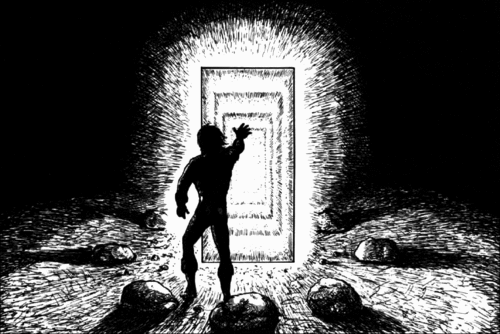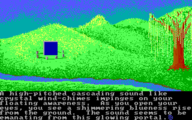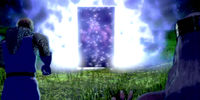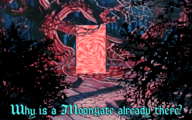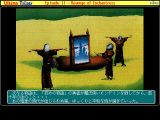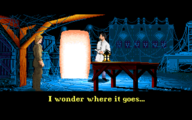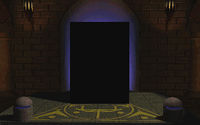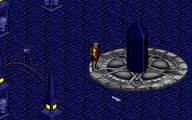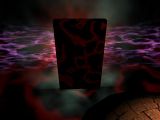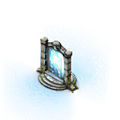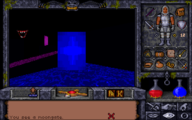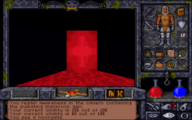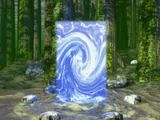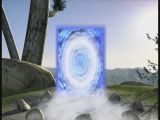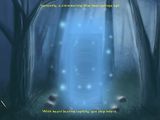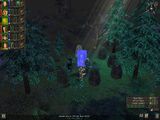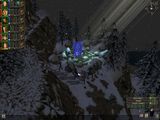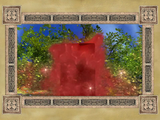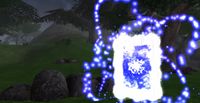Moongate
Moongates are a collective name for a variety of transtemporal, interspatial, and interdimensional gateways that allow for rapid travel from one point in space and/or time to another. These portals are commonplace on Britannia and serve as a means of transit between the various cities of the realm, as well as allowing for travel to and from other worlds.
There are four known types of moongates, the properties of which have changed through the ages. The naturally-occurring blue moongates are most commonly seen throughout the series, but there also exist red, and black gates as well as time doors.
Blue Moongates[edit]
Fixed Blue Moongates[edit]
- For charts detailing the positions and phases of fixed blue moongates, see Blue moongate locations.
Blue moongates are the most commonly seen portals in Britannia, as eight more or less permanent instances of them exist near to the major cities of the land, each at the site of a buried moonstone. These eight gates function based upon the phases of the world's twin moons, Trammel and Felucca – although exactly how they relate to one another mechanically has changed throughout time.
In Ultima III, before the world had fully settled into the classical Britannian landscape, the eight gates nevertheless existed at key points in the realm. During this time and into the early years of Britannia's Age of Enlightenment, the phase of Trammel would determine which gate was open, whereas the phase of Felucca would determine the destination of a traveler stepping through that gate. During Ultima IV, double full moons and double new moons were both significant occurrences, as the former would open a gate to the shrine of Spirituality and the latter would foretell the growth of rare reagents or allow for a questant to locate the Black Stone of Humility.
Later, by the time of Blackthorn's rise to power in Ultima V, the moongates would only appear after dusk, with the phase of the moon highest in the sky determining the destination to which a gate would transpose a traveler. At the hour of midnight, the path to the Shrine of Spirituality would become open, regardless of which moon held the zenith. These celestial mechanics continued to be in play by the time of the Gargish conflict of Ultima VI, although the operation of the moongates had become complicated by the fact that the moonstones were held captive by Draxinusom's forces. As a consequence of these losses, the blue gates would open on the eight shrines where the Gargoyles were laying their siege.
Two centuries later, in an age which seemed to be witnessing the death of magic, the gates began to function erratically, as a result of the Guardian's Sphere Generator. During Ultima VII, each blue moongate remained perpetually open and would transport travelers to the gate associated with the next greatest lunar phase... provided that they did not injure or kill the wayfarer caught within them. Eventually, the Avatar would be forced to destroy the generator corrupting them, which had the unforeseen side effect of ceasing their function entirely.
During the last days of the Avatar, however, in Ultima IX the moongates of Britannia reappeared, although they functioned in a manner notably different from any of their previously seen behaviors and bore a notably purplish hue. These moongates could only be summoned through the magic of the Summon Moongate spell, in which the wayfarer seeking to activate them needed to place an Orb of the Moons (commonly used to summon red gates) upon the site of the gate's moonstone and to then chant the mantra associated with the city to which they wished passage.
Interdimensional Blue Moongates[edit]
Aside from the eight fixed blue moongates of Britannia, there have been historic instances of blue moongates spanning the distance between worlds, particularly between Britannia and Earth. It is written in The Book of Lore that Lord British first crossed over to Sosaria through a blue moongate, which appeared shortly after he uncovered the serpentine amulet which would become the emblem of his rule. While the historian writing of such events remains ambiguous, it is implied in the same work that it was this amulet which would later summon the Stranger to combat the various evils of the Age of Darkness. While it has never been confirmed that the hero used a blue moongate to travel to ancient Sosaria, references exist which refer to a gateway known as the "Siege Perilous," through which the champion supposedly passed.[1][2]
It is further known that when the Stranger came to Britannia to undertake the Quest of the Avatar, that it was a blue moongate which manifested to provide with a pilgrim's ankh and a copy of Kyle the Younger's The History of Britannia. Years later, during the reign of Blackthorn and the Oppression, the former companions of the hero devised a means to manifest such a blue moongate themselves, summoning the Avatar back to the troubled kingdom through means of a special coin, which worked in conjunction with the hero's own ankh amulet to produce a gate.
Red Moongates[edit]
For methods of creating red moongates using an Orb of the Moons, see Orb of the Moons locations
Red moongates are temporary portals created using an Orb of the Moons, a rare and powerful artifact whose origins are unclear. Gate thus summoned can lead virtually anywhere, depending on the user's manipulation of the Orb. Not only can such gates allow for travel within a given world, but it is well established that red moongates allow for travel between worlds, although such a feat requires great skill on the part of an Orb's user.
The Avatar first encountered a red moongate during the rescue of Lord British during Ultima V, in which the monarch used his restored Orb of the Moons to escape from his prison within the dungeon Doom. A little later, the fallen Lord Blackthorn left Britannia in exile through another of these gates.
In Ultima VI, Draxinusom used his Orbs of the Moons to summon the Avatar to the Gargish homelands, intending to sacrifice the "False prophet". In the process, the hero would obtain another such Orb, allowing rapid travel from place to place once safely arriving in Britannia. Later, this artifact would prove an article of scientific curiosity to a scientist on earth known as Eliott Rafkin, and experiments using it would land the hero in the time-warped valley of Eodon, from which Lord British would eventually effect a rescue through means of another red gate.
Centuries later, the Time Lord himself would invoke a red moongate to summon the Avatar, having himself been imprisoned within a loop in the space-time continuum created by the Sphere Generator, which had drastically altered the function of the moongates on Britannia. In order to free the Lord of Time from his celestial cage, the hero would have to destroy this device, causing the Orbs of the Moons to cease functioning and preventing the creation of new red moongates.[3]
Time Doors[edit]
For a list of time gate locations, see List of time gate locations
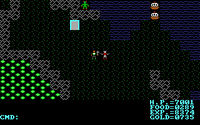
Time doors or time gates, are portals which allow one to travel primarily through time, although they have been established as transporting travelers to different spatial locations as they move them temporally. Such gates featured prominently in Ultima II, in which it was revealed that Mondain's lifeforce had been tied to the fabric of the universe such that when he was slain, a hole began to open in the continuity of space-time, even on far flung Earth. These gates offered the Stranger some hope in preventing the destructive catastrophe which would be enacted by Mondain's paramour, Minax.[4]
Each time gate had a fixed location where it would appear and disappear at regular intervals. Once entered, these time gates would always deposit those who entered them at a set time and location, interconnecting four crucial time periods in Terran history as well as leading to the paradoxical Time of Legends where Minax's stronghold of Shadowguard lay.
Orange Moongate[edit]
Following the Avatar's misadventure with Rafkin in The Savage Empire, the hero became friends with the scientist's colleague whom he had rescued in Eodon, one Johann Spector. After together receiving a mysterious package from a red-haired woman which purported to be records of their adventures in 1895, the pair set out for an abandoned Colorado mine. Using instructions supposedly penned by Spector nearly a century prior, the hero managed to manipulate their Orb of the Moons to produce a gateway in time to the same location in 1895. It appeared to glow with a whitish orange light.
Timegate in the FM Towns-port
Black Moongates[edit]
This section is about the Black Gate phenomenon. For the game, see Ultima VII: The Black Gate.
Black moongates are physically manufactured artifacts which allow for interdimensional travel. Unlike the previously mentioned varieties of moongate, these monoliths do not appear as shimmering doors of light and energy, but rather exist as solid constructs forged of the rare mineral blackrock. "Moongate" may even be something of a misnomer, as these gates have no seemingly relation to lunar cycles but rather must be fueled by external sources of power such as major planetary conjunctions like the astronomical alignment or the Titanic artifacts of Pagan.
The first appearance of a such a moongate in Britannia was the Black Gate which the Guardian's followers erected during the events of Ultima VII, hoping that their master might cross over from his plane to theirs. This project ultimately failed when the Avatar destroyed the portal using Rudyom's Transmuter, barring the malevolent entity from passing through.
The Guardian's foremost adherent, the sage Batlin used means unknown to transport himself to a similarly constructed portal, a blackrock obelisk which had been erected by the Red Titan's followers on the distant Serpent Isle. Similarly, after the Guardian created a great dome of blackrock over Castle Britannia, the Avatar found that a miniaturized "echo" within the gem had similar properties to the Black Gate, allowing the hero to travel to other worlds by passing through its eight faces.
Having weathered such encounters with travel through blackrock artifacts, the hero would go on to escape from the dark world of Pagan, reconstructing the Black Obelisk by reuniting its shards and using them to sap the lifeforce of the planet's four elemental Titans. Using their drained powers to fuel a gateway into the Nexus of the Worlds, the hero was eventually able to return to Britannia.
Another black moongate was seen at Terfin in Ultima IX but unlike before, this gate has red veins through it indicating that the gate might have been repaired from the pieces of the black gate from Ultima VII. The exact nature of this moongate remains unclear, including who built it, when and how they did it, and why the astronomical alignment was not required for the Guardian to use it repeatedly. When the Barrier of Life was created, this gate crumbled into pieces. These chunks subsequently played a significant role in the Ritual of Armageddon that destroyed the Guardian.
Cubic Black Moongate[edit]
During the Avatar's voluntary participation in Dr. Rafkin's examination of a moonstone meteor on Earth, the hero witnessed the doctor's test for the materials electrical conductivity go madly awry when the object absorbed the charge given it and multiplied the electrical power, creating a warped, black moongate which expanded three dimensionally. This strange portal conveyed the Avatar, the scientist and a young journalist named Jimmy Malone to the strange valley of Eodon, a location which existed on Earth in a temporally removed spacetime pocket placing it out of sync with the rest of the planet's history.[5]
The obelisk of Pagan
Lore[edit]
| “ | No one remembers exactly when in history time doors first appeared, probably because their very existence renders time relative. Ancient books show no mention of them prior to the defeat and demise of the evil Mondain, so well recorded in Ultima. Strongly convincing scientific theory supports the chronology. Mondain had gained such power that, upon his death, the physical laws of nature suffered a great upheaval. When the smoke cleared, all that remained were corridors in time and space, we commonly call our "time doors." – from The Second Age of Darkness (Ultima II)
|
|---|
| “ | A new, much larger Siege Perilous has been discovered. The gateway will now hold four adventurers instead of just one... Total concentration among the party is necessary for the gateway of the Siege Perilous to open. A moment of transition is experienced, then... After the darkness of transition clears from thine eyes, a sample view of Sosaria appears. – from The Book of Play (Ultima III)
|
|---|
| “ | The greatest transport are the hidden Moon gates. They are similar, but less powerful, to the Siege Perilous that hast brought thy Party hither. Passing through a Moon Gate when it is active will teleport thy Party to hidden powers. Access to many glens of the old knowledge are restricted by the Moon Gates. No creature of the Dark can ever break through the wards that protect them. The coming and going of the Moon Gates is somehow related to the twin Moons, Trammel and Felucca, that grace out skies. The cartographer, Hawkwind, was supposedly greatly excited about a discovery concerning the true nature of the Moon Gates, when he was attacked. The success of thy quest may well hinge on thou solving this ancient mystery. – from The Book of Play (Ultima III)
|
|---|
| “ | Under the auspices of Lord British, studies of the properties of the Moon gates are beginning to yield a clearer understanding of the Gates' mystical workings. People forecast that future citizens will use these gates as a normal means of distant travel. The destinations of the gates appear to be rigidly bound to the phases of the twin moons Trammel and Felucca. The appearance and disappearance of the gates are represented on most maps of the realm as phases of the moons. The gate active is indicated by the phase of the moon Trammel. Once a gate is entered, thy destination is indicated by the phase of the moon Felucca. – from The History of Britannia (Ultima IV)
|
|---|
| “ | Many tales are told of knights traveling from towne to towne, even across water, merely by stepping into a wall of light. There are few verifiable reports of moongate travel. However, sifting through those reports that are verifiable, it has become clear that they operate as follows.
Each night at the apex of the first moon, Trammel, the eight moongates appear, rectangles of shimmering blue light rising from the ground. They remain until Felucca reaches her apex. While the moongates are open, a traveler entering one will be instantly transported to another moongate in a different locale. The traveler's destination is determined by the phase of the moon closest to midheaven. Moongate travel is said to be fast and safe; however, there have been confusing and conflicting reports of what transpires when the moons are equidistant in the midheaven. Moongate travelers should exercise caution. – from The Book of Lore (Ultima V)
|
|---|
| “ | From a bed of dry leaves, the glint of metal caught his eye. It was a silver medallion in the shape of a great serpent. In his hand, the medallion felt unusually warm. Suddenly a line of blue light rose from the leaves, expanding into a door of shimmering light. The youth stared, astonished, then stepped through. The door disappeared and autumn with it. Green fields now surrounded the youth. – from The Book of Lore (Ultima V)
|
|---|
| “ | There exists an extraordinary cosmic association between the gravity of the moons and the delicate fabric of time and space. As though pulling the strings of some cosmic marionette, the moons cause radiant moongates to appear on the land below. Step through one of these shimmering corridors of light and you will be transported to a new time or place. Moongates generally appear at locations where fragments of extraterrestrial rocks called "moonstones" have been buried. There are at least two types of moongates — blue and red.
Blue moongates, generated by moonstones, generally focus on destinations in but a single world — the world in which they appear. Their power, awesome though it may seem, is limited, allowing the traveler to teleport only from the location of one moonstone to that of another. The moonstone the user travels to is determined by the phase of the moon that appears directly overhead in the sky. Through experimentation and observation, the moongate traveler can correlate the phases of the highest moon with the destination the gate will select. Red gates, generated by the powerful Orb of the Moons, can send the traveler anywhere in Britannia. In fact, the holder of this black stone can teleport to worlds other than his own. I, Lord British, have used the red gates often, but there is, no doubt, much more to be learned about these gates. – from Compendium (Ultima VI)
|
|---|
| “ | During this time of magic, a strange form of travel existed, through doorways of light that were often called "Moongates." There were at least two types of Moongates—blue and red. Blue Moongates sprang up wherever fragments of extraterrestrial rocks called "moonstones" were buried. These gates allowed magical travel from one gate to another.
Red Moongates are generated by the powerful artifact known as the Orb of the Moons. A red Moongate can take a traveler anywhere in Britannia. It has even been said that it can also be used to travel to other worlds. There have only been two red Moongates in all of known existence—one used by Lord British, and the other by the Avatar. Little is known about these gates, but like magic spells, Moongates no longer function as they once did. Use of Moongates today cannot be discouraged strongly enough. They are dangerous and their use in this less-than-reliable state has resulted in numerous fatalities. – from The Book of Fellowship (Ultima VII)
|
|---|
Trivia[edit]
- Richard Garriott borrowed the concept of moongates (as time-travelling portals) from Terry Gilliam's movie, Time Bandits.
- The Siege Perilous was a legendary vacant seat at the Round Table of Cammelot, meant for the knight who could find the Holy Grail.
- Moongates exist in Lord of Ultima, but appear different from their classic counterparts. They seem to be a stone arch with the gate resting within the frame. They allow Lords to send units to other continents.
- In the manga, Ultima: The Terror of Exodus and Ultima: The Quest of the Avatar moongates look very different. Instead of a circle of stones, there is a large megalithic construction, and the function of the gates appear to be bound to the standing stones which surround them, rather than being rooted in buried moonstones.
- In the cancelled Ultima Online 2 and the Technocrat War trilogy, there were three types of moongates that would allow travel throughout Sosaria: City moongates near each major populace, shrine moongates near each of the Shrines of the Virtues, and wilderness moongates located in remote areas of the world. It is currently unknown how these would function for transportation.
- The loading screen of Ultima VII shows what transit through a red moongate looks like from the perspective of the traveler. It can be seen in the gallery.
- In Ultima Underworld and Ultima Underworld II, moongates with unusual colors appear. Observed colors are green, white, orange, purple and yellow. The exact mechanism by which these gates work is unknown. They can be accessed through the Gate Travel spell, as well as by adventuring through the colored realms.
Gallery[edit]
Fan Recreations[edit]
The following gallery shows moongates found in fan-created games.
Production art for Ultima V: Lazarus
The Minoc moongate, as seen in Ultima V: Lazarus and The Ultima 6 Project
Moongate, as intended for the canceled Ultima IX: Redemption
See Also[edit]
References[edit]
- ↑ Garriott, Richard et al. "Folklore". The Book of Lore (Ultima V). Origin Systems, Inc.: 1988. Pages 1-4.
- ↑ Adams, Roe R.. "Preparing for Thy Journey". The Book of Play (Ultima III). Origin Systems, Inc.: 1983. Page 2.
- ↑ Time Lord. Underworld Dragon’s Ultima VII transcript. Ultima VII. "crisis, moongate, Sphere".
- ↑ Rollo, Mary Taylor. "Time Travel". The Second Age of Darkness (Ultima II). Sierra On-Line, Inc.: 1983. Page 6.
- ↑ Allston, Aaron et al. "Valley of the Thunder Lizards, Part One". Ultimate Adventures Magazine (The Savage Empire). Origin Systems, Inc.: 1990. Pages 11-12.
